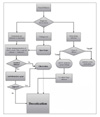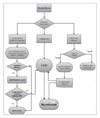Abstract
Background
Since video-assisted thoracoscopic surgery (VATS) was introduced as a new treatment modality for empyema thoracis, numerous reports have suggested that VATS is a more effective treatment method than the traditional methods that mainly use antibiotics and drainage apparatus. However, no confirmative evidence of the superiority of VATS over the traditional method has been provided yet.
Methods
We attempted to evaluate the efficacy of VATS for the treatment of empyema thoracis by reviewing past medical records and simple chest films. First, we divided the patients into two groups based on the treatment method: group A of 15 patients who were treated with the traditional method between January 2001 and December 2003, and group B of 9 patients who were treated with VATS between December 2003 and August 2006. The final outcomes used in this study were the number of days of hospital stay, chest tube duration, leukocytosis duration, febrile duration, and intravenous antibiotics usage duration. In addition, radiological improvements were compared.
Results
The mean age(±standard deviation) of 11 men and 4 women in group A was 58.2±15.7 years, and of 9 men and 2 women in group B was 51.6±9.5 years. Group B had a significantly shorter hospital stay (16.6±7.4 vs. 33.7±22.6 days; p=0.014), shorter chest tube duration (10.5±5.7 vs. 19.5±14.4 days; p=0.039), shorter leukocytosis duration (6.7±6.5 vs. 18.8±13.2 days; p=0.008), shorter febrile duration (0.8±1.8 vs. 9.4±9.2 days; p=0.004), and shorter duration of intravenous antibiotics usage (14.9±6.4 vs. 25.4±13.9 days; p=0.018). However, radiological improvements did not show any statistical differences.
Conclusion
Early application of VATS for empyema thoracis treatment reduced hospital stay, thoracostomy tube duration, leukocytosis duration, febrile duration, and antibiotics usage duration in comparison with the traditional methods. The early performing of VATS might be an effective treatment modality for empyema thoracis.
Figures and Tables
 | Figure 1The Traditional treatment protocol in Chunchon Sacred Heart Hospital (Group A). The dotted line means the occasion of some complication occuring during observation. |
References
1. Lee RB. Sellke FW, Del Nido PJ, Swanson SJ, editors. Chapter 28B. Benign pleural disease: empyema thoracis. Sabiston and Spencer surgery of the chest. 2005. 7th ed. Philadelphia, PA: Elsevier Saunders;431–434.
2. Striffeler H, Gugger M, Im Hof V, Cerny A, Furrer M, Ris H. Video-assisted thoracoscopic surgery for fibrinopurulent pleural empyema in 67 patients. Ann Thorac Surg. 1998. 65:319–323.
3. Suzuki T, Kitami A, Suzki S, Kamio Y, Narushima M, Suzuki H. Video-assisted thoracoscopic sterilization for exacerbation of chronic empyema thoracis. Chest. 2001. 119:277–280.
4. Kim BY, Oh BS, Jang WC, Min YI, Park YK, Park JC. Video-assisted thoracoscopic decortication for management of postpneumonic pleural empyema. Am J Surg. 2004. 188:321–324.
5. Son JH, Shin YC, Mo E, Chee HK, Kim EJ, Shin HS. Video-assisted thoracoscopic surgery for fibrinopurulent empyema. Korean J Thorac Cardiovasc Surg. 2003. 36:404–410.
6. Maier A, Domej W, Anegg U, Woltsche M, Fell B, Pinter H, et al. Computed tomography or ultrasonically guided pigtail catheter drainage in multiloculated pleural empyema: a recommended procedure? Respirology. 2000. 5:119–124.
7. Jimenez Castro D, Diaz G, Perez-Rodriguez E, Light RW. Prognostic features of residual pleural thickening in parapneumonic pleural effusions. Eur Respir J. 2003. 21:952–955.
8. de Pablo A, Villena V, Echave-Sustaeta J, Encuentra AL. Are pleural fluid parameters related to the development of residual pleural thickening in tuberculosis? Chest. 1997. 112:1293–1297.
9. Wyser C, Walzl G, Smedema J, Swart F, van Schalkwyk EM, van de Wal BW. Corticosteroids in the treatment of tuberculous pleurisy: a double-blind, placebo-controlled, randomized study. Chest. 1996. 110:333–338.
10. Cottagnoud P, Tomasz A. Triggering of pneumococcal autolysis by lysozyme. J Infect Dis. 1993. 167:684–690.
11. Light RW. Light RW, editor. Chapter 9. Parapneumonic effusions and empyema, Chapter 10. Tuberculous pleural effusions. Pleural disease. 2001. 4th ed. Philadelphia, PA: Lippincott Williams & Wilkins;151–195.
12. Carey JA, Hamilton JR, Spencer DA, Gould K, Hasan A. Empyema thoracis: a role for open thoracotomy and decortication. Arch Dis Child. 1998. 79:510–513.
13. Mandal AK, Thadepalli H, Mandal AK, Chettipally U. Outcome of primary empyema thoracis: therapeutic and microbiologic aspects. Ann Thorac Surg. 1998. 66:1782–1786.
14. Wait MA, Sharma S, Hohn J, Nogare AD. A randomized trial of empyema therapy. Chest. 1997. 111:1548–1551.
15. Landreneau RJ, Keenan RJ, Hazelrigg SR, Mack MJ, Naunheim KS. Thoracoscopy for empyema and hemothorax. Chest. 1996. 109:18–24.
16. Rodriguez JA, Hill CB, Loe WA Jr, Kirsch DS, Liu DC. Video-assisted thoracoscopic surgery for children with stage II empyema. Am Surg. 2000. 66:569–573.
17. Kim YJ. Video-assisted thoracoscopy in the treatment of multi loculated pleural effusion and empyema. Korean J Thorac Cardiovasc Surg. 2004. 37:160–165.
18. Luh SP, Chou MC, Wang LS, Chen JY, Tsai TP. Video-assisted thoracoscopic surgery in the treatment of complicated parapneumonic effusions or empyemas. Chest. 2005. 127:1427–1432.
19. Coote N, Kay E. Surgical versus non-surgical management of pleural empyema(review). The Cochrane database of systemic reviews 2005. (Issue 4):Art. No:CD001956.pub2.
20. Banga A, Khilnani GC, Sharma SK, Dey AB, Wig N, Banga N. A study of empyema thoracis and role of intrapleural streptokinase in its management. BMC Infect Dis. 2004. 4:19.
21. Pierrepoint MJ, Evans A, Morris SJ, Harrison SK, Doull IJ. Pigtail catheter drain in the treatment of empyema thoracis. Arch Dis Child. 2002. 87:331–332.
22. Barnes NP, Hull J, Thomson AH. Medical management of parapnuemonic pleural disease. Pediatric Pulmonol. 2005. 39:127–134.
23. Balci AE, Eren S, Ulku R, Eren MN. Management of multiloculated empyema thoracis in children: thoracotomy versus fibrinolytic treatment. Eur J Cardiothoracic Surg. 2002. 22:595–598.
24. Bouros D, Antoniou KM, Chalkiadakis G, Drositis J, Petrakis I, Siafakas N. The role of video-assisted thoracoscopic surgery in the treatment of parapneumonic empyema after the failure of fibrinolytics. Surg Endosc. 2002. 16:151–154.
25. Lawrence DR, Ohri SK, Moxon RE, Townsend ER, Fountain SW. Thoracoscopic debridement of empyema thoracis. Ann Thorac Surg. 1997. 64:1148–1150.




 PDF
PDF ePub
ePub Citation
Citation Print
Print




 XML Download
XML Download